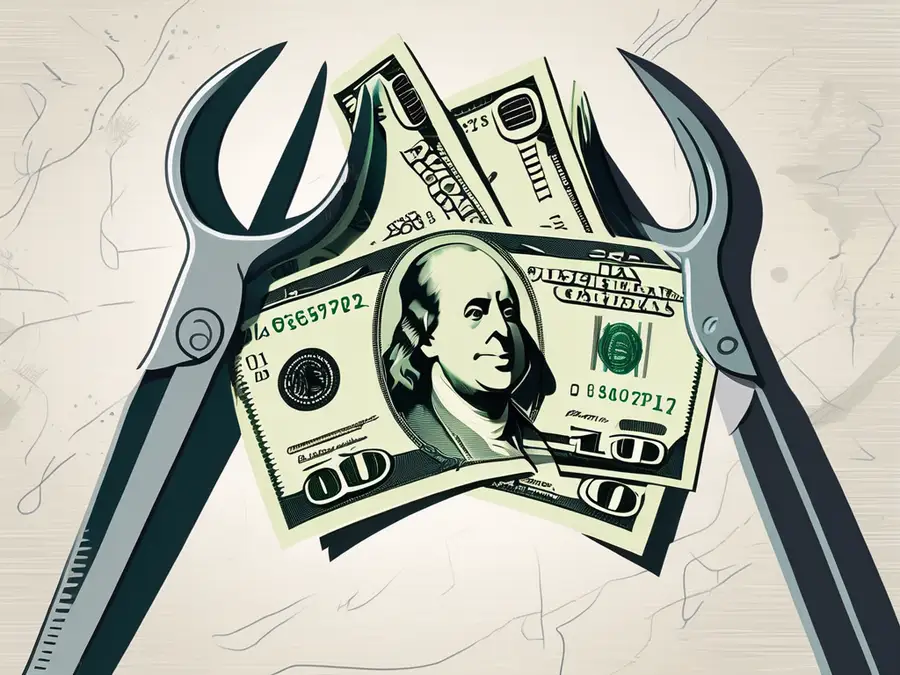Understanding Financial Haircuts: A Crucial Aspect in Risk Management

As an expert in risk management, I cannot stress enough the importance of understanding financial haircuts. These seemingly simple calculations play a crucial role in managing risk and ensuring the stability of financial markets. In this article, we will delve into the concept of financial haircuts, their role in risk management, how they are calculated, their impact on investment decisions, the regulatory aspects surrounding them, and future trends in this field.
Defining Financial Haircuts
The Concept and Importance of Financial Haircuts
Financial haircuts are a risk management technique used to assess the value of an asset or security in relation to its market price. They act as a buffer or margin of safety to account for potential losses in case the value of the asset or security decreases. By applying a haircut, lenders and investors can protect themselves against unexpected market fluctuations.
Financial haircuts are essential because they help prevent a small decline in asset value from triggering a sell-off or a default. They provide a cushion and allow for a more accurate assessment of the risk associated with an investment.
Let's dive deeper into the concept of financial haircuts and explore their significance in different scenarios.
Different Types of Financial Haircuts
There are various types of financial haircuts, each tailored to specific types of assets or securities. Some common types include:
Equity Haircuts: These apply to stocks and represent the percentage by which the market value of the stock is reduced.
Equity haircuts play a crucial role in the valuation of stocks. They consider factors such as market volatility, company performance, and industry trends to determine the appropriate haircut percentage. This percentage acts as a safety net, protecting investors from sudden drops in stock prices and ensuring a more accurate assessment of the investment's risk.
Bond Haircuts: Bonds are subject to haircuts based on their credit rating, maturity date, and liquidity.
Bond haircuts are particularly important in the fixed-income market. They take into account various factors such as the creditworthiness of the issuer, the time to maturity, and the market liquidity of the bond. By applying a bond haircut, investors can mitigate the risk of default and adjust the bond's value to reflect its inherent risk.
Collateral Haircuts: Used in secured lending, these haircuts take into account the quality and liquidity of the collateral.
Collateral haircuts are commonly employed in secured lending transactions, where borrowers provide collateral to secure a loan. These haircuts consider the quality and liquidity of the collateral, ensuring that lenders have a sufficient margin of safety in case the collateral's value declines. By applying a collateral haircut, lenders can protect themselves from potential losses and maintain a balanced risk-reward ratio.
Understanding the different types of financial haircuts is crucial for investors, lenders, and risk managers. By incorporating these risk management techniques into their strategies, they can make more informed decisions, safeguard their investments, and navigate the ever-changing financial landscape with confidence.
The Role of Financial Haircuts in Risk Management
Financial haircuts play a significant role in mitigating credit risk, especially in the banking sector. By applying haircuts to collateral, lenders can ensure that they have sufficient protection in case of default or market downturns. Haircuts are an essential tool for managing counterparty risk and maintaining the stability of the financial system.
When a borrower pledges collateral to secure a loan, the lender may apply a haircut to the value of that collateral. This means that the lender will only consider a portion of the collateral's value when calculating the loan-to-value ratio. The haircut serves as a buffer against potential losses, as it accounts for the uncertainty and volatility of the underlying asset.
For example, if a borrower pledges a piece of real estate worth $1 million as collateral, and the lender applies a 20% haircut, the effective value of the collateral for risk management purposes would be $800,000. This reduction in value provides the lender with a cushion to absorb potential losses in case the borrower defaults or the market value of the collateral declines.
Mitigating Credit Risk with Financial Haircuts
Financial haircuts are particularly effective in mitigating credit risk. They act as a safeguard for lenders, reducing the likelihood and severity of losses resulting from defaulting borrowers. By adjusting the value of collateral through haircuts, lenders can better align the loan amount with the actual risk associated with the borrower.
Moreover, haircuts also serve as a means of incentivizing borrowers to maintain the value of the collateral. If the borrower allows the collateral to deteriorate or its market value to decline significantly, the lender may require additional collateral or adjust the haircut accordingly. This encourages borrowers to take necessary measures to protect the collateral, reducing the overall credit risk.
Financial institutions, such as banks, heavily rely on haircuts to manage their credit risk exposure. By applying appropriate haircuts to various types of collateral, banks can ensure that they have adequate protection against potential losses. This risk management practice is crucial for maintaining the stability and soundness of the banking system, as it helps prevent excessive credit risk accumulation.
Financial Haircuts as a Tool for Market Stability
In addition to credit risk, financial haircuts also contribute to market stability. They discourage excessive leverage and speculative activities by increasing the costs associated with risky investments. By imposing haircuts on certain assets, regulators can prevent market manipulation and protect investors from undue losses.
Financial markets are inherently exposed to various risks, including market volatility and liquidity constraints. Haircuts act as a mechanism to address these risks by reducing the value of assets used as collateral. This reduction in value reflects the potential loss that could occur in adverse market conditions, prompting market participants to exercise caution and prudence in their investment decisions.
Furthermore, haircuts help maintain market integrity by deterring market participants from engaging in manipulative practices. By applying haircuts to certain assets, regulators can limit the potential gains that can be obtained through market manipulation. This discourages unethical behavior and promotes fair and transparent trading practices, ultimately enhancing market stability.
Overall, financial haircuts serve as a vital risk management tool in both credit risk and market stability. They provide lenders with a cushion against potential losses, encourage responsible borrowing and investing behavior, and contribute to the overall stability of the financial system. By understanding and effectively implementing haircuts, financial institutions and regulators can better navigate the complex landscape of risk management and safeguard the interests of all stakeholders involved.
Calculating Financial Haircuts
A financial haircut is a risk management technique used to determine the value of an asset or security that can be used as collateral. It represents the percentage reduction in the value of the asset that will be applied when determining its eligibility as collateral. The size of a financial haircut depends on various factors, including the liquidity of the asset, its volatility, and historical price fluctuations.
When assessing the liquidity of an asset, market participants consider factors such as the ease with which it can be bought or sold without significantly impacting its price. Highly liquid assets, such as government bonds or large-cap stocks, generally have lower haircuts compared to illiquid assets like real estate or private equity.
Volatility is another crucial factor in determining the size of a financial haircut. Assets with higher price volatility are considered riskier and therefore subject to larger haircuts. This is because a higher volatility implies a greater potential for price fluctuations, which increases the risk of loss for the lender in the event of default.
Historical price fluctuations also play a role in determining the financial haircut. By analyzing past performance, market participants can assess the asset's price stability and the likelihood of significant price declines. Assets with a history of large price swings are subject to larger haircuts to account for the increased risk.
In addition to the asset-specific factors, the creditworthiness of the issuer or borrower is also taken into consideration. A higher haircut may be applied if the issuer or borrower has a lower credit rating or a history of default. This reflects the increased risk associated with lending against assets issued by entities with a higher probability of default.
Furthermore, prevailing market conditions can influence the haircut applied. During periods of financial stress or market volatility, market participants may increase haircuts to account for the heightened risk environment. Conversely, in more stable market conditions, haircuts may be reduced to reflect the lower perceived risk.
The Process of Determining a Financial Haircut
The process of determining a financial haircut involves careful analysis and evaluation. Market participants, such as banks and regulatory bodies, employ various techniques to assess the characteristics of the asset or security.
One common approach is to use statistical models that consider historical price data, market volatility, and other relevant factors. These models can help quantify the potential risk associated with the asset and provide a basis for determining an appropriate haircut percentage.
Stress testing is another important tool used in the determination of financial haircuts. By subjecting the asset or security to various hypothetical scenarios, market participants can assess its resilience and potential losses under adverse market conditions. The results of stress testing can inform the decision-making process and lead to adjustments in the haircut percentage.
Expert judgment also plays a role in determining financial haircuts. Experienced professionals with in-depth knowledge of the asset class or market segment can provide valuable insights and assess the specific risks associated with the asset. Their expertise helps ensure that the haircut accurately reflects the underlying risk.
It is important to note that financial haircuts are not static and can be subject to periodic review and adjustment. As market conditions change and new information becomes available, market participants may revise the haircuts to reflect the evolving risk landscape.
In conclusion, calculating financial haircuts involves considering various factors such as asset liquidity, volatility, historical price fluctuations, creditworthiness, and prevailing market conditions. The process of determining a financial haircut requires careful analysis, including the use of statistical models, stress testing, and expert judgment. By accurately assessing the risks associated with an asset or security, financial haircuts help mitigate potential losses and ensure the stability of financial markets.
The Impact of Financial Haircuts on Investment Decisions
Financial Haircuts and Portfolio Management
Financial haircuts have a significant impact on portfolio management. They influence investment strategies and risk appetite, as investors need to account for the potential reduction in the value of their assets. Portfolio managers must consider haircuts when diversifying their investments and constructing a balanced portfolio.
When it comes to portfolio management, financial haircuts play a crucial role in determining the level of risk an investor is willing to take. A financial haircut represents a percentage reduction in the value of an asset that is used to calculate its collateral value. This reduction acts as a cushion against potential losses, ensuring that investors are not caught off guard in times of market volatility.
For example, let's say an investor holds a portfolio consisting of various stocks and bonds. Each of these assets has a different level of risk associated with it. By applying appropriate haircuts to each asset, the investor can adjust their portfolio's overall risk level. This allows them to strike a balance between potential returns and the need for capital preservation.
Furthermore, financial haircuts also influence investment strategies. Portfolio managers need to consider the haircut applied to a particular asset when deciding whether to buy, sell, or hold it. A higher haircut may discourage investment in certain assets, as it implies a higher level of risk. On the other hand, a lower haircut may make an asset more attractive, as it suggests a lower risk of potential losses.
Financial Haircuts and Investor Confidence
Financial haircuts are crucial for maintaining investor confidence in the stability of financial markets. By implementing appropriate haircuts, regulators and market participants can instill trust and prevent excessive risk-taking. Investors feel more secure knowing that there are measures in place to mitigate potential losses.
Investor confidence is a cornerstone of any healthy financial market. Without it, investors may hesitate to participate, leading to reduced liquidity and overall market inefficiencies. Financial haircuts help address this concern by providing a safety net that protects investors from the full impact of market downturns.
Moreover, financial haircuts also serve as a signal of the regulatory framework's effectiveness. When regulators enforce appropriate haircuts, they demonstrate their commitment to maintaining market stability and protecting investors' interests. This, in turn, fosters trust and encourages market participants to engage in responsible investment practices.
It is worth noting that the establishment of financial haircuts requires a delicate balance. While haircuts should be sufficient to mitigate potential losses, they should not be overly conservative, as this could hinder market liquidity and discourage investment. Striking the right balance is essential to ensure that financial haircuts effectively protect investors while still allowing for efficient capital allocation.
In conclusion, financial haircuts have a profound impact on investment decisions and investor confidence. They play a crucial role in portfolio management, influencing strategies and risk appetite. Additionally, financial haircuts are essential for maintaining trust in financial markets and preventing excessive risk-taking. By implementing appropriate haircuts, regulators and market participants can strike a balance between protecting investors and promoting market efficiency.
Regulatory Aspects of Financial Haircuts
Global Standards for Financial Haircuts
Financial haircuts are subject to global standards and guidelines developed by regulatory bodies such as the Basel Committee on Banking Supervision. These standards ensure consistency and promote a level playing field across different jurisdictions. Compliance with these standards is crucial for institutions operating in the international financial system.
The Role of Regulatory Bodies in Financial Haircuts
Regulatory bodies play a vital role in monitoring and enforcing the use of appropriate financial haircuts. They set guidelines, conduct inspections, and assess the adequacy of haircuts implemented by financial institutions. By overseeing the application of haircuts, regulators contribute to the stability and integrity of financial markets.
Future Trends in Financial Haircuts
Technological Advances and Financial Haircuts
As technology continues to advance, it is expected to have a significant impact on the calculation and implementation of financial haircuts. Automation, artificial intelligence, and machine learning algorithms can improve the accuracy and efficiency of haircut calculations. This can lead to more precise risk assessments and better risk management overall.
The Impact of Economic Changes on Financial Haircuts
Economic changes, such as shifts in interest rates or market volatility, can have a direct impact on the size and application of financial haircuts. As economic conditions evolve, haircuts may need to be adjusted to reflect changing risk profiles. Market participants and regulators must closely monitor economic indicators and adapt haircut policies accordingly.
Understanding financial haircuts is essential for anyone involved in risk management and investing. By recognizing the concept and importance of financial haircuts, knowing how to calculate them, and understanding their impact on investment decisions, you can make informed choices and navigate the world of finance with confidence.
Personal Advice: As an expert in risk management, I have witnessed the profound impact that financial haircuts can have on investment outcomes. I have seen portfolios thrive due to prudent allocation of assets and appropriate application of haircuts. However, I have also seen the consequences of underestimating the importance of haircuts, leading to substantial losses. Therefore, my advice to investors and risk managers is to always consider financial haircuts as an integral part of the risk mitigation strategy.
FAQ
What are financial haircuts?
Financial haircuts are adjustments made to the value of an asset or security to account for potential losses due to market fluctuations. They act as a buffer or margin of safety, protecting lenders and investors from unexpected declines in the value of their investments.
What is the role of financial haircuts in risk management?
Financial haircuts play a crucial role in risk management by mitigating credit risk and maintaining market stability. They help prevent excessive leverage, discourage speculative activities, and provide a more accurate assessment of the risk associated with an investment.
How are financial haircuts calculated?
The calculation of financial haircuts involves analyzing factors such as asset liquidity, volatility, historical price fluctuations, and creditworthiness. Market participants use statistical models, stress testing, and expert judgment to determine an appropriate haircut percentage.
What is the impact of financial haircuts on investment decisions?
Financial haircuts influence investment strategies, risk appetite, and portfolio management decisions. They require investors to account for potential reductions in the value of their assets and promote investor confidence by ensuring measures are in place to mitigate potential risks.
How do regulatory bodies oversee financial haircuts?
Regulatory bodies develop global standards for financial haircuts and monitor their implementation by financial institutions. They play a crucial role in assessing the adequacy of haircuts, conducting inspections, and promoting the stability and integrity of financial markets.
What are the future trends in financial haircuts?
Technological advances, such as automation and artificial intelligence, are expected to impact the calculation and implementation of financial haircuts. Additionally, economic changes, such as interest rate shifts or market volatility, may necessitate adjustments to reflect evolving risk profiles.
As you navigate the complexities of financial haircuts and their pivotal role in risk management, consider the advantages of a platform that aligns with your need for precision and innovation. Morpher is not just a trading platform; it's a revolution in the investment world, leveraging blockchain technology to offer a seamless, fee-free trading experience across a multitude of asset classes. With Morpher, you can trade with confidence, utilizing tools like fractional investing, short selling without interest fees, and up to 10x leverage to enhance your financial strategies. Embrace the future of trading with a platform that offers safety, control, and a unique trading experience. Sign Up and Get Your Free Sign Up Bonus today, and join the community of traders who are already shaping the world of investing with Morpher.

Disclaimer: All investments involve risk, and the past performance of a security, industry, sector, market, financial product, trading strategy, or individual’s trading does not guarantee future results or returns. Investors are fully responsible for any investment decisions they make. Such decisions should be based solely on an evaluation of their financial circumstances, investment objectives, risk tolerance, and liquidity needs. This post does not constitute investment advice.

Painless trading for everyone
Hundreds of markets all in one place - Apple, Bitcoin, Gold, Watches, NFTs, Sneakers and so much more.

Painless trading for everyone
Hundreds of markets all in one place - Apple, Bitcoin, Gold, Watches, NFTs, Sneakers and so much more.









